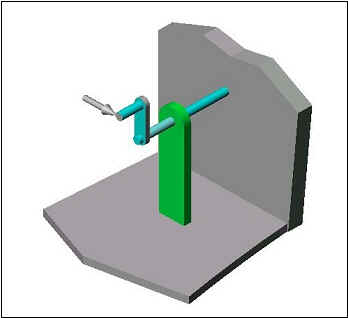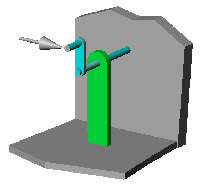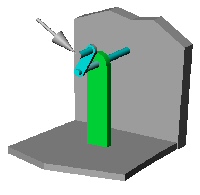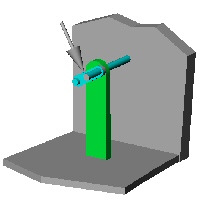- Power and Torque -
ESSENTIAL CONCEPTS:
Torque is measured; Power is calculated
NOTE: All our Products, Designs, and Services are SUSTAINABLE, ORGANIC, GLUTEN-FREE, CONTAIN NO GMO's, and will not upset anyone's precious FEELINGS or delicate SENSIBILITIES.
In order to understand POWER, you must first understand ENERGY and WORK. If you have not reviewed these concepts for a while, it would be helpful to do so before studying this article. CLICK HERE for a quick review of Energy and Work.
(NOTE: There is a LONGER VERSION of this page in the Engine Technology section, with more information which relates specifically to piston engines.)
POWER is defined as the rate of doing WORK, or WORK per unit TIME. Sometimes it seems that people are confused about the relationship between POWER and TORQUE. For example, we have heard engine builders, camshaft consultants, and other "technical experts" ask customers:
"Do you want your engine to make HORSEPOWER or TORQUE?"
And the question is usually asked in a tone of voice which strongly suggests that these "experts" believe power and torque are somehow mutually exclusive.
In fact, the opposite is true, and you should be clear on these facts:
- POWER (the rate of doing WORK) is dependent on TORQUE and RPM.
- TORQUE and RPM are the MEASURED quantities of engine output.
- POWER is CALCULATED from torque and RPM, by the following equation:
HP = Torque x RPM ÷ 5252
(At the bottom of this page, the derivation of that equation is shown, for anyone interested.)
Engines (and motors) produce POWER by providing a ROTATING SHAFT which can exert a given amount of TORQUE on a load at a given RPM. The amount of TORQUE the engine can exert usually varies with RPM.
TORQUE
TORQUE is defined as a FORCE around a given point, applied at a RADIUS from that point. Note that the unit of TORQUE is one pound-foot (often misstated), while the unit of WORK is one foot-pound.

Figure 1
Referring to Figure 1, assume that the handle is attached to the crank-arm so that it is parallel to the supported shaft and is located at a radius of 12" from the center of the shaft. In this example, consider the shaft to be fixed to the wall. Let the arrow represent a 100 lb. force, applied in a direction perpendicular to both the handle and the crank-arm, as shown.
Because the shaft is fixed to the wall, the shaft does not turn, but there is a torque of 100 pounds-feet (100 pounds times 1 foot) applied to the shaft.
Note that IF the crank-arm in the sketch was twice as long (i.e. the handle was located 24" from the center of the shaft), the same 100 pound force applied to the handle would produce 200 lb-ft of torque (100 pounds times 2 feet).
POWER
POWER is the measure of how much WORK can be done in a specified TIME. In the example on the Work and Energy page, the guy pushing the car did 16,500 foot-pounds of WORK. If he did that work in two minutes, he would have produced 8250 foot-pounds per minute of POWER (165 feet x 100 pounds ÷ 2 minutes). If you are unclear about WORK and ENERGY, it would be a benefit to review those concepts HERE.
In the same way that one ton is a large amount of weight (by definition, 2000 pounds), one horsepower is a large amount of power. The definition of one horsepower is 33,000 foot-pounds per minute. The power which the guy produced by pushing his car across the lot (8250 foot-pounds-per-minute) equals ¼ horsepower (8,250 ÷ 33,000).
OK, all that’s fine, but how does pushing a car across a parking lot relate to rotating machinery?
Consider the following change to the handle-and-crank-arm sketch above. The handle is still 12" from the center of the shaft, but now, instead of being fixed to the wall, the shaft now goes through the wall, supported by frictionless bearings, and is attached to a generator behind the wall.
Suppose, as illustrated in Figure 2, that a constant force of 100 lbs. is somehow applied to the handle so that the force is always perpendicular to both the handle and the crank-arm as the crank turns. In other words, the "arrow" rotates with the handle and remains in the same position relative to the crank and handle, as shown in the sequence below. (That is called a "tangential force").



Figure 2
If that constant 100 lb. tangential force applied to the 12" handle (100 lb-ft of torque) causes the shaft to rotate at 2000 RPM, then the power the shaft is transmitting to the generator behind the wall is 38 HP, calculated as follows:
100 lb-ft of torque (100 lb. x 1 foot) times 2000 RPM divided by 5252 is 38 HP.
The following examples illustrate several different values of TORQUE which produce 300 HP.
Example 1: How much TORQUE is required to produce 300 HP at 2700 RPM?
since HP = TORQUE x RPM ÷ 5252
then by rearranging the equation:
TORQUE = HP x 5252 ÷ RPM
Answer: TORQUE = 300 x 5252 ÷ 2700 = 584 lb-ft.
Example 2: How much TORQUE is required to produce 300 HP at 4600 RPM?
Answer: TORQUE = 300 x 5252 ÷ 4600 = 343 lb-ft.
Example 3: How much TORQUE is required to produce 300 HP at 8000 RPM?
Answer: TORQUE = 300 x 5252 ÷ 8000 = 197 lb-ft.
Example 4: How much TORQUE does the 41,000 RPM turbine section of a 300 HP gas turbine engine produce?
Answer: TORQUE = 300 x 5252 ÷ 41,000 = 38.4 lb-ft.
Example 5: The output shaft of the gearbox of the engine in Example 4 above turns at 1591 RPM. How much TORQUE is available on that shaft?
Answer: TORQUE = 300 x 5252 ÷ 1591 = 991 lb-ft.
(ignoring losses in the gearbox, of course).
The point to be taken from those numbers is that a given amount of horsepower can be made from an infinite number of combinations of torque and RPM.
There is a longer version of this page in the Engine Technology section, with more information which relates specifically to piston engines.
Power to Drive a Pump
In the course of working with lots of different engine projects, we often hear the suggestion that engine power can be increased by the use of a "better" oil pump. Implicit in that suggestion is the belief that a "better" oil pump has higher pumping efficiency, and can, therefore, deliver the required flow at the required pressure while consuming less power from the crankshaft to do so. While that is technically true, the magnitude of the improvement number is surprisingly small.
How much power does it take to drive a pump delivering a known flow at a known pressure? We have already shown that power is work per unit time, and we will stick with good old American units for the time being (foot-pounds per minute and inch-pounds per minute). And we know that flow times pressure equals POWER, as shown by:
Flow (cubic inches / minute) multiplied by pressure (pounds / square inch) = POWER (inch-pounds / minute)
From there it is simply a matter of multiplying by the appropriate constants to produce an equation which calculates HP from pressure times flow. Since flow is more freqently given in gallons per minute, and since it is well known that there are 231 cubic inches in a gallon, then:
Flow (GPM) x 231(cubic inches / gal) = Flow (cubic inches per minute).
Since, as explained above, 1 HP is 33,000 foot-pounds of work per minute, multiplying that number by 12 produces the number of inch-pounds of work per minute in one HP (396,000). Dividing 396,000 by 231 gives the units-conversion factor of 1714.3. Therefore, the simple equation is:
Pump HP = flow (GPM) x pressure (PSI) / 1714.
That equation represents the power consumed by a pump having 100% efficiency. When the equation is modified to include pump efficiency, it becomes:
Pump HP = (flow {GPM} x pressure {PSI} / (1714 x efficiency)
Common gear-type pumps typically operate at between 75 and 80% efficiency. So suppose your all-aluminum V8 engine requires 10 GPM at 50 psi. The oil pump will have been sized to maintain some preferred level of oil pressure at idle when the engine and oil are hot, so the pump will have far more capacity than is required to maintain the 10 GPM at 50 psi at operating speed. (That's what the "relief" valve does: bypasses the excess flow capacity back to the inlet of the pump, which, as an added benefit, also dramatically reduces the prospect cavitation in the pump inlet line.)
Now suppose your 75%-efficient pump is maintaining 50 psi at 3000 RPM, and is providing the 10 GPM needed by the engine. It is actually pumping 30 to 50 GPM ( 10 of which goes through the engine, and the excess flow recirculates through the relief valve ) at 50 psi. The power to drive that pressure pump stage is:
HP = ( 50 gpm x 50 psi ) / ( 1714 x 0.75 efficiency ) = 1.95 HP
Suppose you succumb to the hype and shuck out some really big bucks for an allegedly 90% efficient pump. That pump (at the same flow and pressure) will consume:
HP = ( 50 gpm x 50 psi ) / ( 1714 x 0.90 efficiency ) = 1.62 HP.
WOW. A net gain of a full 1/3 of a HP. Can YOUR dyno even measure a 1-HP difference accurately and repeatably?
Derivation of the Power Equation
(for anyone interested)
This part might not be of interest to most readers, but several people have asked:
"OK, if HP = RPM x TORQUE ÷ 5252, then where does the 5252 come from?"
Here is the answer.
By definition, POWER = FORCE x DISTANCE ÷ TIME (as explained above under the POWER heading)
Using the example in Figure 2 above, where a constant tangential force of 100 pounds was applied to the 12" handle rotating at 2000 RPM, we know the force involved, so to calculate power, we need the distance the handle travels per unit time, expressed as:
Power = 100 pounds x distance per minute
OK, how far does the crank handle move in one minute? First, determine the distance it moves in one revolution:
DISTANCE per revolution = 2 x π x radius
DISTANCE per revolution. = 2 x 3.1416 x 1 ft = 6.283 ft.
Now we know how far the crank moves in one revolution. How far does the crank move in one minute?
DISTANCE per min. = 6.283 ft .per rev. x 2000 rev. per min. = 12,566 feet per minute
Now we know enough to calculate the power, defined as:
POWER = FORCE x DISTANCE ÷ TIME
so
Power = 100 lb x 12,566 ft. per minute = 1,256,600 ft-lb per minute
Swell, but how about HORSEPOWER? Remember that one HORSEPOWER is defined as 33000 foot-pounds of work per minute. Therefore HP = POWER (ft-lb per min) ÷ 33,000. We have already calculated that the power being applied to the crank-wheel above is 1,256,600 ft-lb per minute.
How many HP is that?
HP = (1,256,600 ÷ 33,000) = 38.1 HP.
Now we combine some stuff we already know to produce the magic 5252. We already know that:
TORQUE = FORCE x RADIUS.
If we divide both sides of that equation by RADIUS, we get:
(a) FORCE = TORQUE ÷ RADIUS
Now, if DISTANCE per revolution = RADIUS x 2 x π, then
(b) DISTANCE per minute = RADIUS x 2 x π x RPM
We already know
(c) POWER = FORCE x DISTANCE per minute
So if we plug the equivalent for FORCE from equation (a) and distance per minute from equation (b) into equation (c), we get:
POWER = (TORQUE ÷ RADIUS) x (RPM x RADIUS x 2 x π)
Dividing both sides by 33,000 to find HP,
HP = TORQUE ÷ RADIUS x RPM x RADIUS x 2 x π ÷ 33,000
By reducing, we get
HP = TORQUE x RPM x 6.28 ÷ 33,000
Since
33,000 ÷ 6.2832 = 5252
Therefore
HP = TORQUE x RPM ÷ 5252
Note that at 5252 RPM, torque and HP are equal. At any RPM below 5252, the value of torque is greater than the value of HP; Above 5252 RPM, the value of torque is less than the value of HP.

